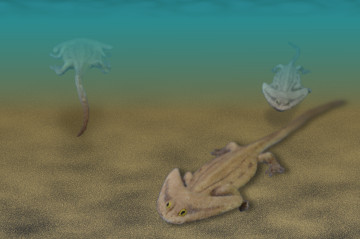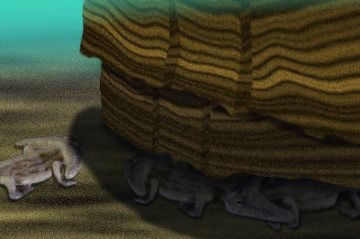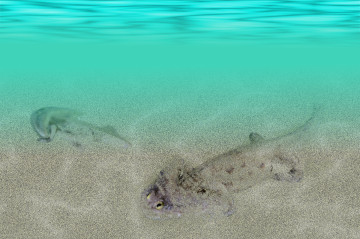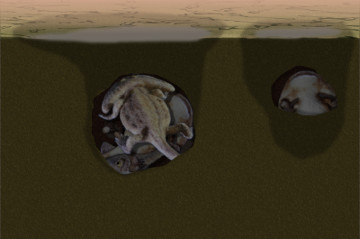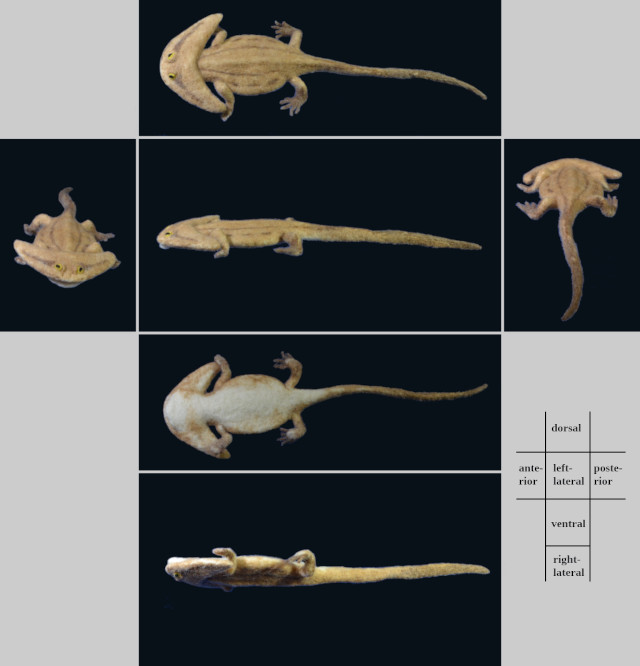Diplocaulus sp.
Diplocaulus is a genus of amphibians, lived in the Permian period 1), 2), 3), perhaps appeared from the Upper Carboniferous 5). Diplocaulus salamadroides was first described by Cope in 1877 2) and very large species, D. magnicornis was also described by Cope in 1882 3). They lived in the non-marine environments, and would have been totally aquatic 6).
Diplocaulus is a curius creature. They have a large and flat head, with posterior lateral horns, so their head looks like a boomerang. Their trunk are short and stumpy, their tails are flat and long (perhaps, reaching to a half of total body length 5)).
There is a discussion that Diplocaulus were active midwater feeders preying on small animals using their unique physical properties of the head based on the experiments of the model in a wind-tunnel 4).
But, their heads were too large, and their limbs were too small to walk on the land, and thus, they would have been bottom dwellars, or sluggish swimmers 5), 6).
Their eyes looked directly upward and their teeth are delicate and small 5). Therefore, they meight have fed soft animals such as annelids in the mud, or may have been vegitable diets 5). Anyway, they could not have been taking a active prey from the water 5).
They may have blended into the mud or sand of bottom excluding their eyes, like some flounders species.
Diplocaulus might have made burrows in the mud to escape from predators, or may have burrowed to protect themselves in the dry season, namely, they would have been aestivators 6), 7). Actually, a cluster of juvenile Diplocaulus was found from the mud burrow, which had wounds bitten by Dimetrodon 7) (which looks like a dinasaur, but is more related to mammals than to reptiles). Apparently, they had played an important role in the food web of predator Dimetrodon.
The coloring of this needle-felting work was reffered the brown frogs (or pond frogs, Rana), additionally, the forms of four legs and tail was referred the newts. It looks like a silly with upward-looking eyes.
created in July - August 2018.
modified in March 2020.
modified in March 2020.
References :
- Bakker RT, Flis CJ, George CD, Cook LA, Bell TH, Zoehfeld KW (2015) Dimetrodon and the earliest apex predators : The Craddock Bone Bed and George Ranch facies show that aquatic prey, not herbivores, were key food sources. Society of Vertebrate Paleontology 75th Annual Meeting Program & Abstracts. (Technical Session III Wed. Oct 14, 2015).
- Cope ED (1877) Descriptions of Extinct Vertebrata from the Permian and Triassic Formamations of the United States. Proc. Am. Philos. Soc. 17(100) : pp. 182-193
- Cope ED (1882) Third Contribution to the History of the Vertebrata of the Permian Formation of Texas. Proc. Am. Philos. Soc. 20(112) : pp. 447-461
- Cruickshank ARI, Skews BW (1980) The functional significance of nectridean tabular horns (Amphibia: Lepospondyli). [abstract] Proc. R. Soc. Lond. B. 209 : 513-537. (DOI: 10.1098/rspb.1980.0110)
- Douthitt H (1917) The structure and relations of Diplocaulus. (Contributions from Walker Museum, vol.II, No.1The University of Chicago Press. Chicago.
- Olson EC (1951) Diplocaulus - A study in growth and variation - . Chicago Natural History Museum Press. Fieldiana: Geology. v.11(2). Chicago.
- Zoehfeld KW, Bakker RT, Flis CJ, Pettersson CB, Bell TH (2013) Burros and break-ins on the Texas Permian delta : Stacked aestivating amphibians and attacks by Dimetrodon. [abstract] The Geological Society of America 125th Anniversary Annual Meeting & expo. Paper No.55.
(also referred to Pappas S (2013) Finned Monster Chomped Heads Off Ancient Amphibians. Live Sicence Oct. 31, 2013. News )

